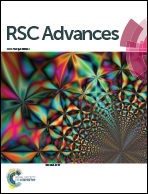NiO hierarchical hollow nanofibers as high-performance supercapacitor electrodes
Abstract
NiO hierarchical hollow nanofibers (hhNFs) consisting of nanosized NiO particles have been synthesized with electrospun poly(amic acid) nanofiber templates through a simple ion-exchange process and subsequent thermal annealing. By virtue of the hierarchical porous fiber-like morphology, as confirmed by the microstructure analysis, the hhNFs possess dense ion transportation channels, interconnected electron diffusion paths, as well as good structure stability, which are conducive to electrochemical capacitor (i.e., supercapacitor) applications. Electrochemical measurements have validated the excellent electrochemical performance of as-prepared hhNFs, including a high specific capacitance of 700 F g−1 at a discharge current of 2 A g−1, a good cyclic stability (96% capacity retention after 5000 cycles at 5 A g−1), and a remarkable rate capability (80% capacitance retention with the current density increasing from 1 to 5 A g−1). These results along with the simplicity and high efficiency of the material preparation demonstrate that NiO hhNFs are promising electrode materials for high-performance supercapacitor applications. The method presented in this work could be extended to the fabrication of other hierarchical fiber-like nanomaterials for applications including electrochemical capacitors and secondary batteries.


 Please wait while we load your content...
Please wait while we load your content...